Consumer Behaviour: Theories, Themes, Limitations, and Prospective
VerifiedAdded on 2023/06/07
|7
|1493
|197
Essay
AI Summary
This essay explores various theories of consumer behaviour, highlighting common and different themes across multiple studies. It discusses the influence of subjective norms, societal factors, marital status, time consumption, price, and personal experiences on consumer buying decisions. The essay also acknowledges the limitations of existing research, such as sample size and scope, and suggests future research directions, including the integration of altruism, ethics, and social responsibility into consumer behaviour models. The analysis draws from studies examining consumer behaviour in different contexts, including the impact of customer cards and the role of experience marketing.
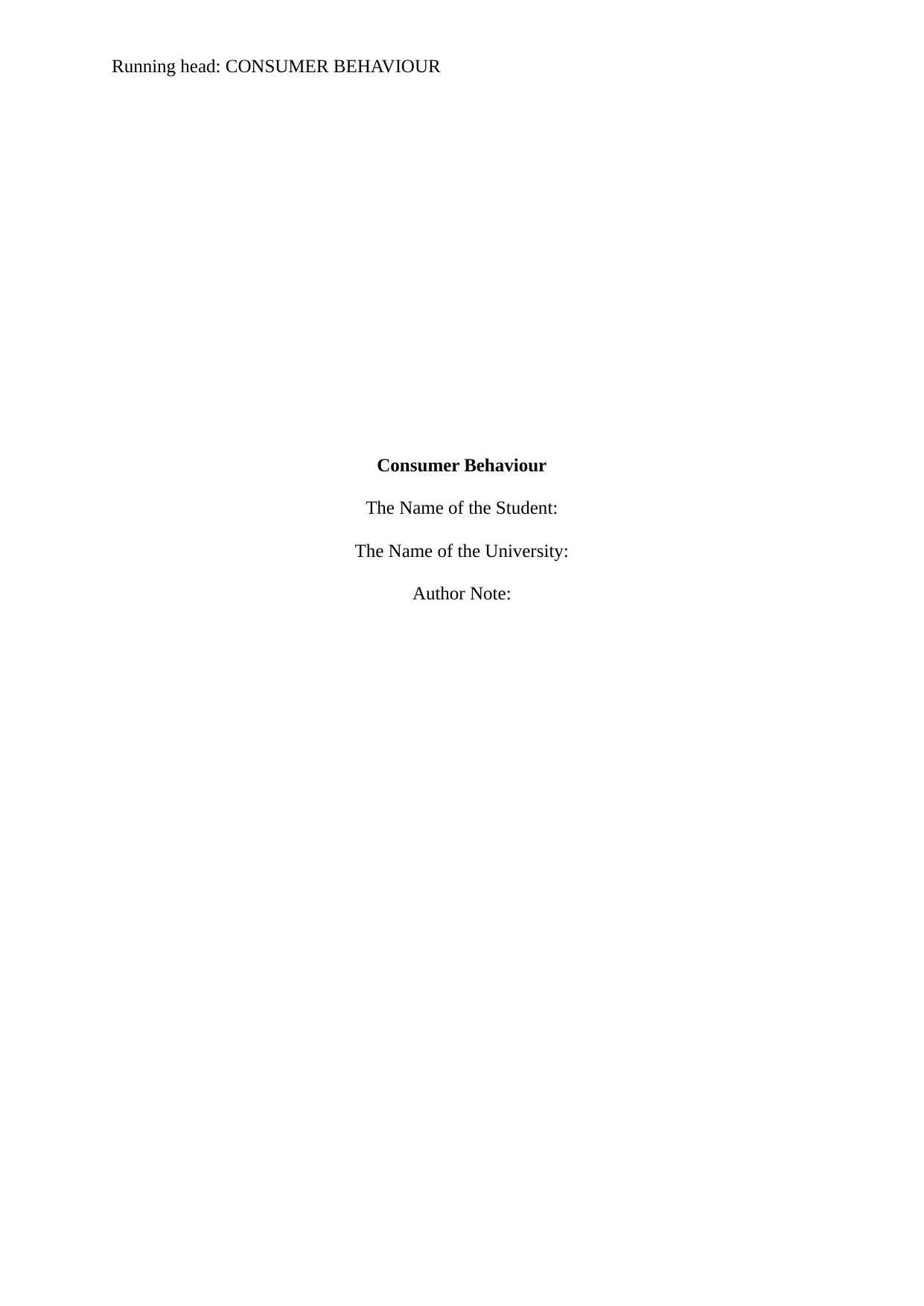
Running head: CONSUMER BEHAVIOUR
Consumer Behaviour
The Name of the Student:
The Name of the University:
Author Note:
Consumer Behaviour
The Name of the Student:
The Name of the University:
Author Note:
Paraphrase This Document
Need a fresh take? Get an instant paraphrase of this document with our AI Paraphraser
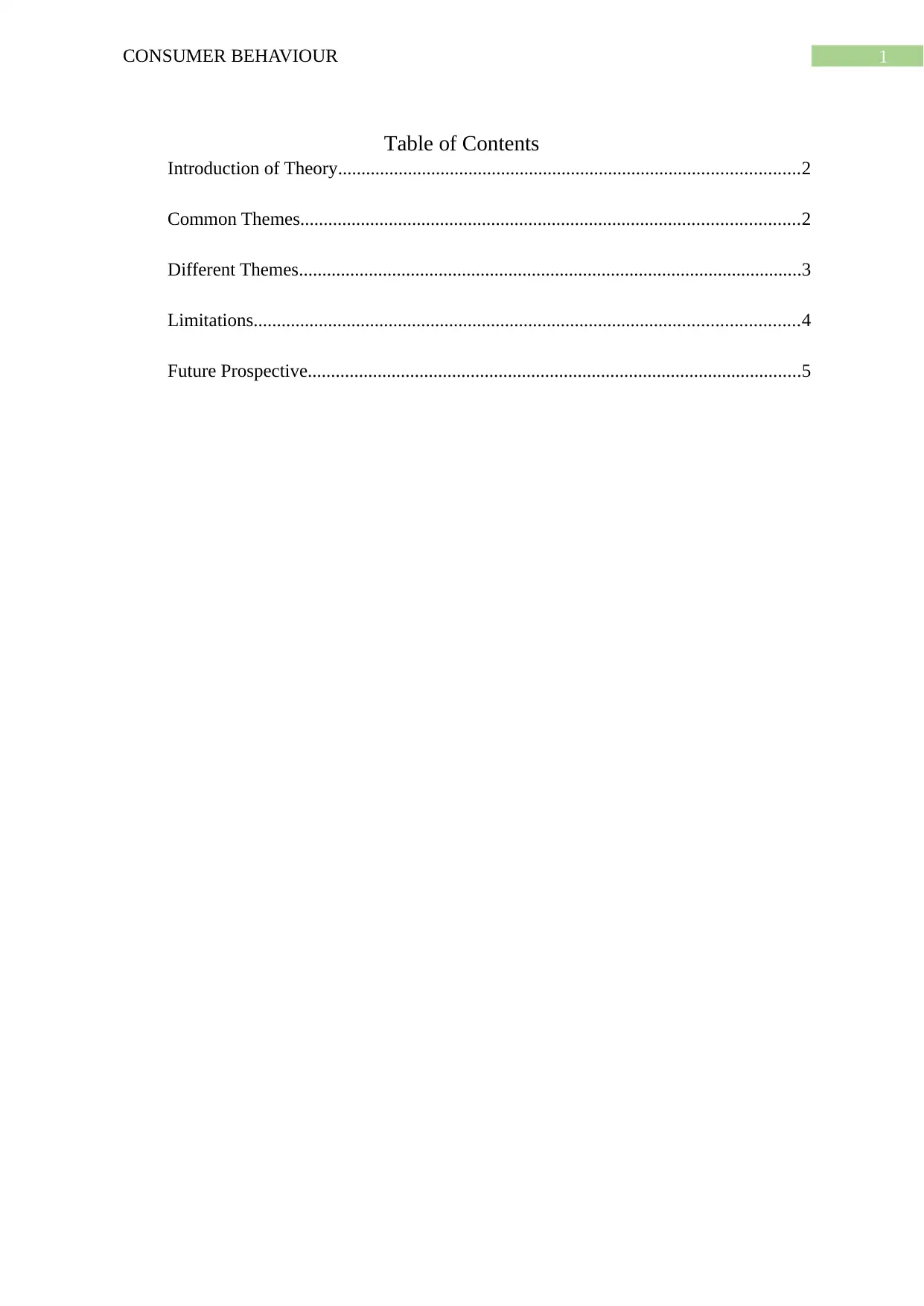
1CONSUMER BEHAVIOUR
Table of Contents
Introduction of Theory...................................................................................................2
Common Themes...........................................................................................................2
Different Themes............................................................................................................3
Limitations.....................................................................................................................4
Future Prospective..........................................................................................................5
Table of Contents
Introduction of Theory...................................................................................................2
Common Themes...........................................................................................................2
Different Themes............................................................................................................3
Limitations.....................................................................................................................4
Future Prospective..........................................................................................................5
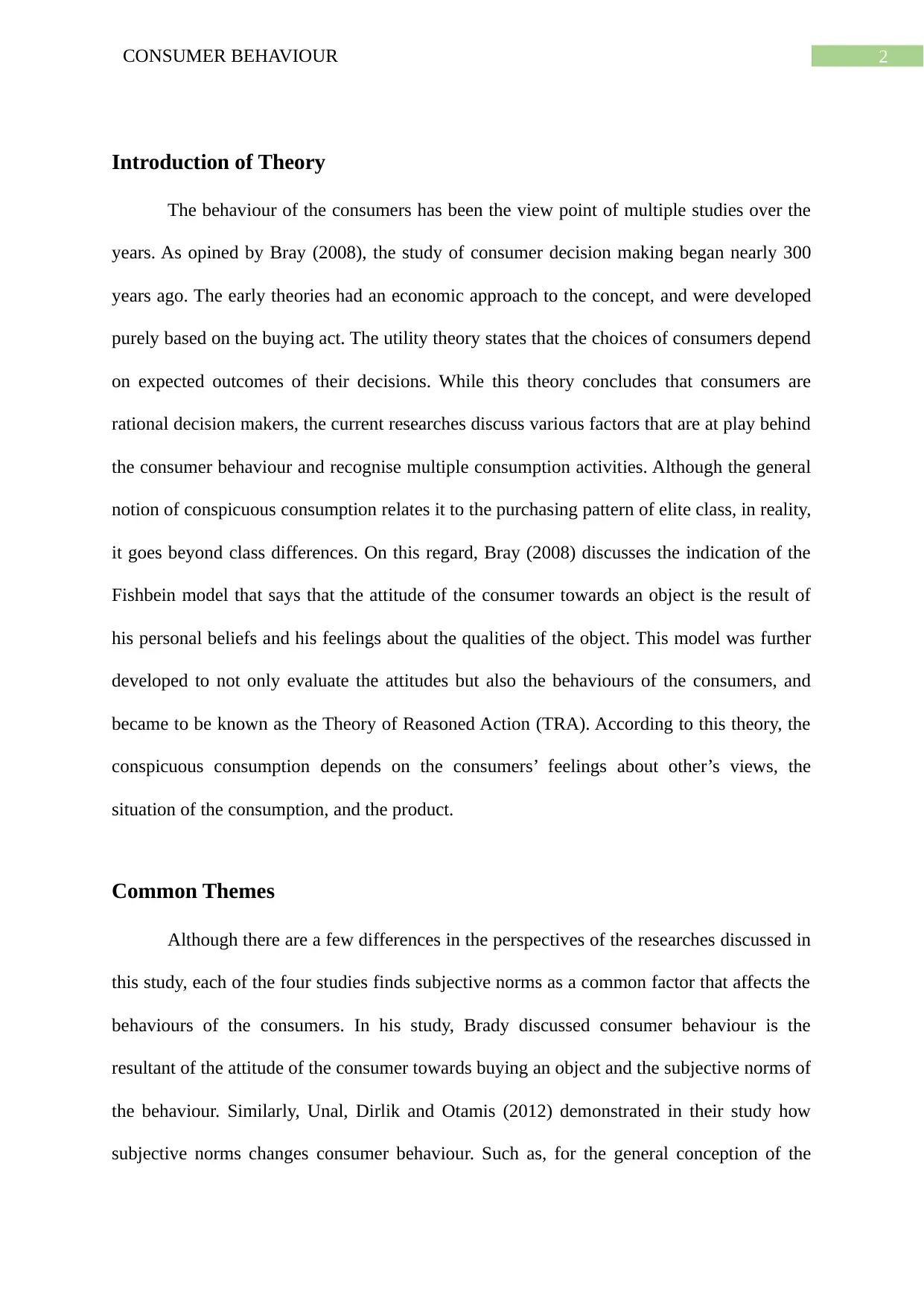
2CONSUMER BEHAVIOUR
Introduction of Theory
The behaviour of the consumers has been the view point of multiple studies over the
years. As opined by Bray (2008), the study of consumer decision making began nearly 300
years ago. The early theories had an economic approach to the concept, and were developed
purely based on the buying act. The utility theory states that the choices of consumers depend
on expected outcomes of their decisions. While this theory concludes that consumers are
rational decision makers, the current researches discuss various factors that are at play behind
the consumer behaviour and recognise multiple consumption activities. Although the general
notion of conspicuous consumption relates it to the purchasing pattern of elite class, in reality,
it goes beyond class differences. On this regard, Bray (2008) discusses the indication of the
Fishbein model that says that the attitude of the consumer towards an object is the result of
his personal beliefs and his feelings about the qualities of the object. This model was further
developed to not only evaluate the attitudes but also the behaviours of the consumers, and
became to be known as the Theory of Reasoned Action (TRA). According to this theory, the
conspicuous consumption depends on the consumers’ feelings about other’s views, the
situation of the consumption, and the product.
Common Themes
Although there are a few differences in the perspectives of the researches discussed in
this study, each of the four studies finds subjective norms as a common factor that affects the
behaviours of the consumers. In his study, Brady discussed consumer behaviour is the
resultant of the attitude of the consumer towards buying an object and the subjective norms of
the behaviour. Similarly, Unal, Dirlik and Otamis (2012) demonstrated in their study how
subjective norms changes consumer behaviour. Such as, for the general conception of the
Introduction of Theory
The behaviour of the consumers has been the view point of multiple studies over the
years. As opined by Bray (2008), the study of consumer decision making began nearly 300
years ago. The early theories had an economic approach to the concept, and were developed
purely based on the buying act. The utility theory states that the choices of consumers depend
on expected outcomes of their decisions. While this theory concludes that consumers are
rational decision makers, the current researches discuss various factors that are at play behind
the consumer behaviour and recognise multiple consumption activities. Although the general
notion of conspicuous consumption relates it to the purchasing pattern of elite class, in reality,
it goes beyond class differences. On this regard, Bray (2008) discusses the indication of the
Fishbein model that says that the attitude of the consumer towards an object is the result of
his personal beliefs and his feelings about the qualities of the object. This model was further
developed to not only evaluate the attitudes but also the behaviours of the consumers, and
became to be known as the Theory of Reasoned Action (TRA). According to this theory, the
conspicuous consumption depends on the consumers’ feelings about other’s views, the
situation of the consumption, and the product.
Common Themes
Although there are a few differences in the perspectives of the researches discussed in
this study, each of the four studies finds subjective norms as a common factor that affects the
behaviours of the consumers. In his study, Brady discussed consumer behaviour is the
resultant of the attitude of the consumer towards buying an object and the subjective norms of
the behaviour. Similarly, Unal, Dirlik and Otamis (2012) demonstrated in their study how
subjective norms changes consumer behaviour. Such as, for the general conception of the
⊘ This is a preview!⊘
Do you want full access?
Subscribe today to unlock all pages.

Trusted by 1+ million students worldwide
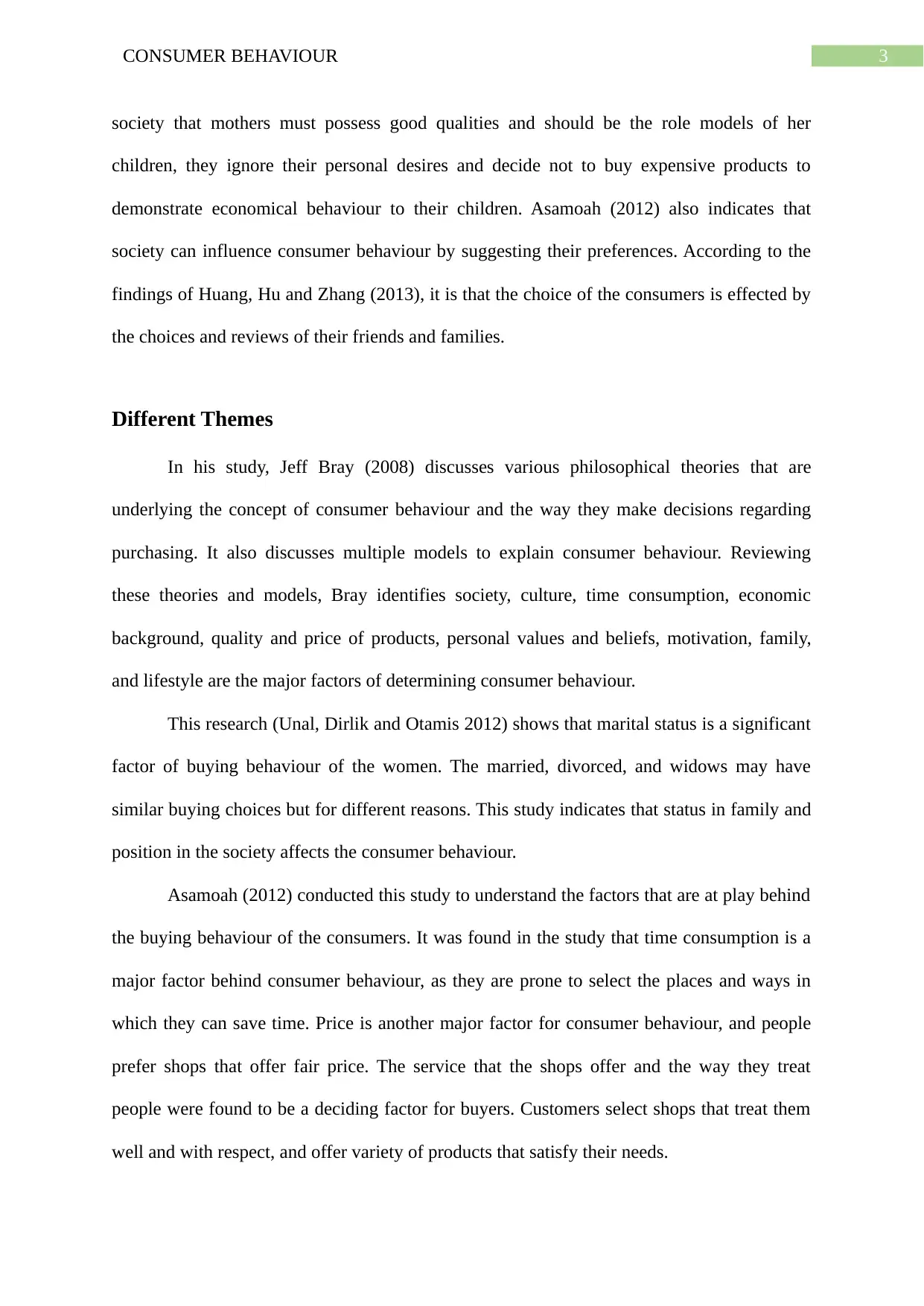
3CONSUMER BEHAVIOUR
society that mothers must possess good qualities and should be the role models of her
children, they ignore their personal desires and decide not to buy expensive products to
demonstrate economical behaviour to their children. Asamoah (2012) also indicates that
society can influence consumer behaviour by suggesting their preferences. According to the
findings of Huang, Hu and Zhang (2013), it is that the choice of the consumers is effected by
the choices and reviews of their friends and families.
Different Themes
In his study, Jeff Bray (2008) discusses various philosophical theories that are
underlying the concept of consumer behaviour and the way they make decisions regarding
purchasing. It also discusses multiple models to explain consumer behaviour. Reviewing
these theories and models, Bray identifies society, culture, time consumption, economic
background, quality and price of products, personal values and beliefs, motivation, family,
and lifestyle are the major factors of determining consumer behaviour.
This research (Unal, Dirlik and Otamis 2012) shows that marital status is a significant
factor of buying behaviour of the women. The married, divorced, and widows may have
similar buying choices but for different reasons. This study indicates that status in family and
position in the society affects the consumer behaviour.
Asamoah (2012) conducted this study to understand the factors that are at play behind
the buying behaviour of the consumers. It was found in the study that time consumption is a
major factor behind consumer behaviour, as they are prone to select the places and ways in
which they can save time. Price is another major factor for consumer behaviour, and people
prefer shops that offer fair price. The service that the shops offer and the way they treat
people were found to be a deciding factor for buyers. Customers select shops that treat them
well and with respect, and offer variety of products that satisfy their needs.
society that mothers must possess good qualities and should be the role models of her
children, they ignore their personal desires and decide not to buy expensive products to
demonstrate economical behaviour to their children. Asamoah (2012) also indicates that
society can influence consumer behaviour by suggesting their preferences. According to the
findings of Huang, Hu and Zhang (2013), it is that the choice of the consumers is effected by
the choices and reviews of their friends and families.
Different Themes
In his study, Jeff Bray (2008) discusses various philosophical theories that are
underlying the concept of consumer behaviour and the way they make decisions regarding
purchasing. It also discusses multiple models to explain consumer behaviour. Reviewing
these theories and models, Bray identifies society, culture, time consumption, economic
background, quality and price of products, personal values and beliefs, motivation, family,
and lifestyle are the major factors of determining consumer behaviour.
This research (Unal, Dirlik and Otamis 2012) shows that marital status is a significant
factor of buying behaviour of the women. The married, divorced, and widows may have
similar buying choices but for different reasons. This study indicates that status in family and
position in the society affects the consumer behaviour.
Asamoah (2012) conducted this study to understand the factors that are at play behind
the buying behaviour of the consumers. It was found in the study that time consumption is a
major factor behind consumer behaviour, as they are prone to select the places and ways in
which they can save time. Price is another major factor for consumer behaviour, and people
prefer shops that offer fair price. The service that the shops offer and the way they treat
people were found to be a deciding factor for buyers. Customers select shops that treat them
well and with respect, and offer variety of products that satisfy their needs.
Paraphrase This Document
Need a fresh take? Get an instant paraphrase of this document with our AI Paraphraser
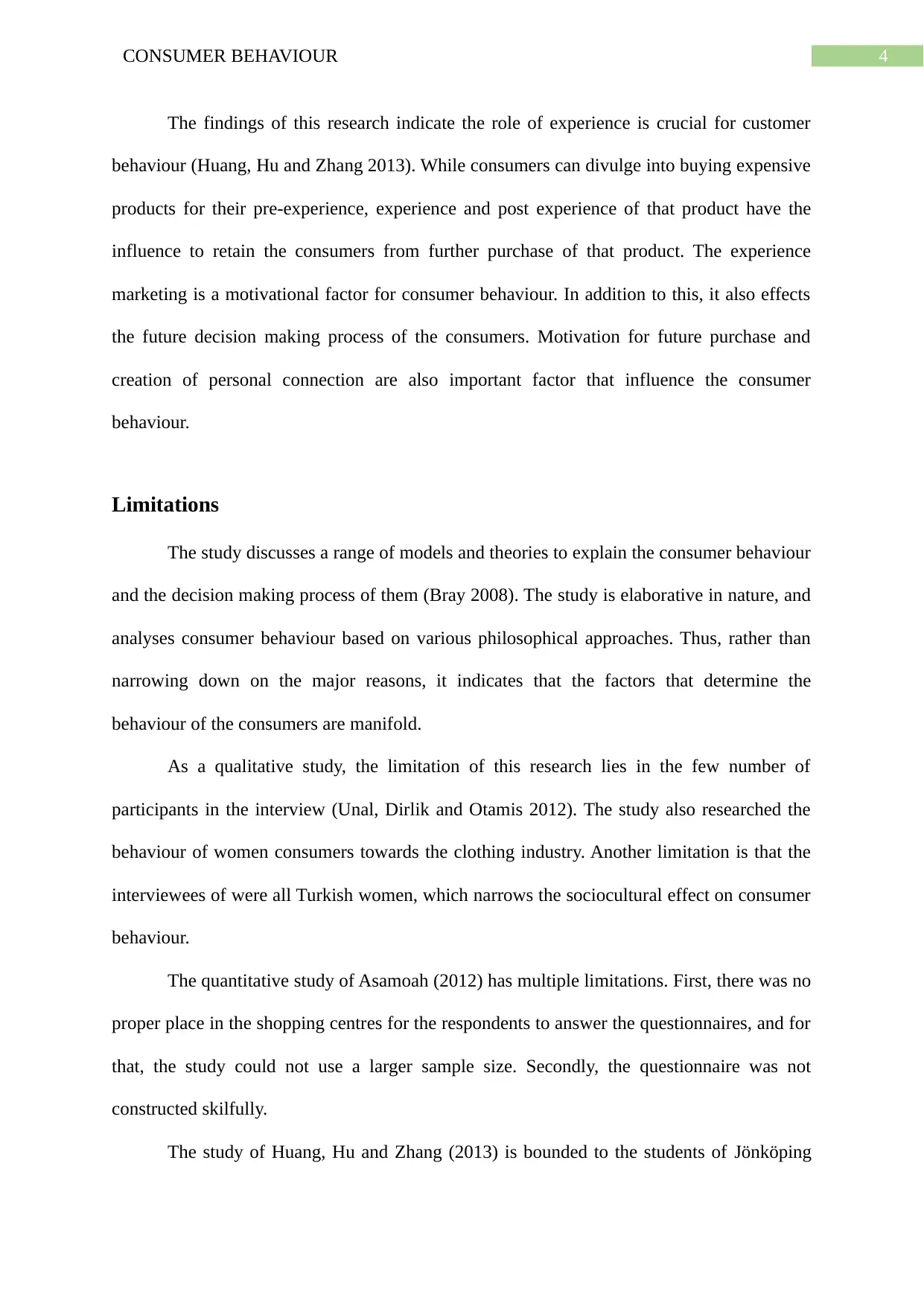
4CONSUMER BEHAVIOUR
The findings of this research indicate the role of experience is crucial for customer
behaviour (Huang, Hu and Zhang 2013). While consumers can divulge into buying expensive
products for their pre-experience, experience and post experience of that product have the
influence to retain the consumers from further purchase of that product. The experience
marketing is a motivational factor for consumer behaviour. In addition to this, it also effects
the future decision making process of the consumers. Motivation for future purchase and
creation of personal connection are also important factor that influence the consumer
behaviour.
Limitations
The study discusses a range of models and theories to explain the consumer behaviour
and the decision making process of them (Bray 2008). The study is elaborative in nature, and
analyses consumer behaviour based on various philosophical approaches. Thus, rather than
narrowing down on the major reasons, it indicates that the factors that determine the
behaviour of the consumers are manifold.
As a qualitative study, the limitation of this research lies in the few number of
participants in the interview (Unal, Dirlik and Otamis 2012). The study also researched the
behaviour of women consumers towards the clothing industry. Another limitation is that the
interviewees of were all Turkish women, which narrows the sociocultural effect on consumer
behaviour.
The quantitative study of Asamoah (2012) has multiple limitations. First, there was no
proper place in the shopping centres for the respondents to answer the questionnaires, and for
that, the study could not use a larger sample size. Secondly, the questionnaire was not
constructed skilfully.
The study of Huang, Hu and Zhang (2013) is bounded to the students of Jönköping
The findings of this research indicate the role of experience is crucial for customer
behaviour (Huang, Hu and Zhang 2013). While consumers can divulge into buying expensive
products for their pre-experience, experience and post experience of that product have the
influence to retain the consumers from further purchase of that product. The experience
marketing is a motivational factor for consumer behaviour. In addition to this, it also effects
the future decision making process of the consumers. Motivation for future purchase and
creation of personal connection are also important factor that influence the consumer
behaviour.
Limitations
The study discusses a range of models and theories to explain the consumer behaviour
and the decision making process of them (Bray 2008). The study is elaborative in nature, and
analyses consumer behaviour based on various philosophical approaches. Thus, rather than
narrowing down on the major reasons, it indicates that the factors that determine the
behaviour of the consumers are manifold.
As a qualitative study, the limitation of this research lies in the few number of
participants in the interview (Unal, Dirlik and Otamis 2012). The study also researched the
behaviour of women consumers towards the clothing industry. Another limitation is that the
interviewees of were all Turkish women, which narrows the sociocultural effect on consumer
behaviour.
The quantitative study of Asamoah (2012) has multiple limitations. First, there was no
proper place in the shopping centres for the respondents to answer the questionnaires, and for
that, the study could not use a larger sample size. Secondly, the questionnaire was not
constructed skilfully.
The study of Huang, Hu and Zhang (2013) is bounded to the students of Jönköping
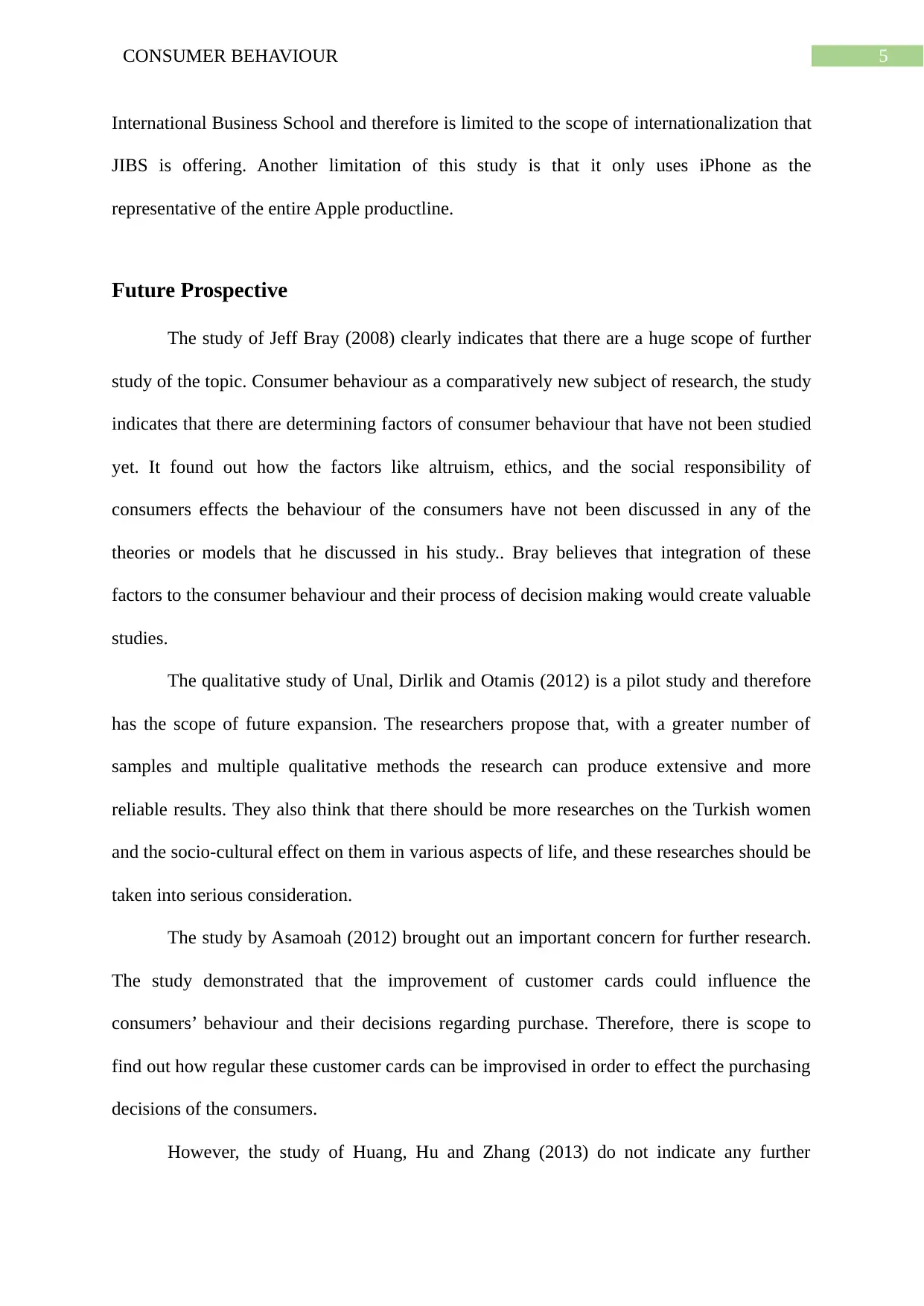
5CONSUMER BEHAVIOUR
International Business School and therefore is limited to the scope of internationalization that
JIBS is offering. Another limitation of this study is that it only uses iPhone as the
representative of the entire Apple productline.
Future Prospective
The study of Jeff Bray (2008) clearly indicates that there are a huge scope of further
study of the topic. Consumer behaviour as a comparatively new subject of research, the study
indicates that there are determining factors of consumer behaviour that have not been studied
yet. It found out how the factors like altruism, ethics, and the social responsibility of
consumers effects the behaviour of the consumers have not been discussed in any of the
theories or models that he discussed in his study.. Bray believes that integration of these
factors to the consumer behaviour and their process of decision making would create valuable
studies.
The qualitative study of Unal, Dirlik and Otamis (2012) is a pilot study and therefore
has the scope of future expansion. The researchers propose that, with a greater number of
samples and multiple qualitative methods the research can produce extensive and more
reliable results. They also think that there should be more researches on the Turkish women
and the socio-cultural effect on them in various aspects of life, and these researches should be
taken into serious consideration.
The study by Asamoah (2012) brought out an important concern for further research.
The study demonstrated that the improvement of customer cards could influence the
consumers’ behaviour and their decisions regarding purchase. Therefore, there is scope to
find out how regular these customer cards can be improvised in order to effect the purchasing
decisions of the consumers.
However, the study of Huang, Hu and Zhang (2013) do not indicate any further
International Business School and therefore is limited to the scope of internationalization that
JIBS is offering. Another limitation of this study is that it only uses iPhone as the
representative of the entire Apple productline.
Future Prospective
The study of Jeff Bray (2008) clearly indicates that there are a huge scope of further
study of the topic. Consumer behaviour as a comparatively new subject of research, the study
indicates that there are determining factors of consumer behaviour that have not been studied
yet. It found out how the factors like altruism, ethics, and the social responsibility of
consumers effects the behaviour of the consumers have not been discussed in any of the
theories or models that he discussed in his study.. Bray believes that integration of these
factors to the consumer behaviour and their process of decision making would create valuable
studies.
The qualitative study of Unal, Dirlik and Otamis (2012) is a pilot study and therefore
has the scope of future expansion. The researchers propose that, with a greater number of
samples and multiple qualitative methods the research can produce extensive and more
reliable results. They also think that there should be more researches on the Turkish women
and the socio-cultural effect on them in various aspects of life, and these researches should be
taken into serious consideration.
The study by Asamoah (2012) brought out an important concern for further research.
The study demonstrated that the improvement of customer cards could influence the
consumers’ behaviour and their decisions regarding purchase. Therefore, there is scope to
find out how regular these customer cards can be improvised in order to effect the purchasing
decisions of the consumers.
However, the study of Huang, Hu and Zhang (2013) do not indicate any further
⊘ This is a preview!⊘
Do you want full access?
Subscribe today to unlock all pages.

Trusted by 1+ million students worldwide
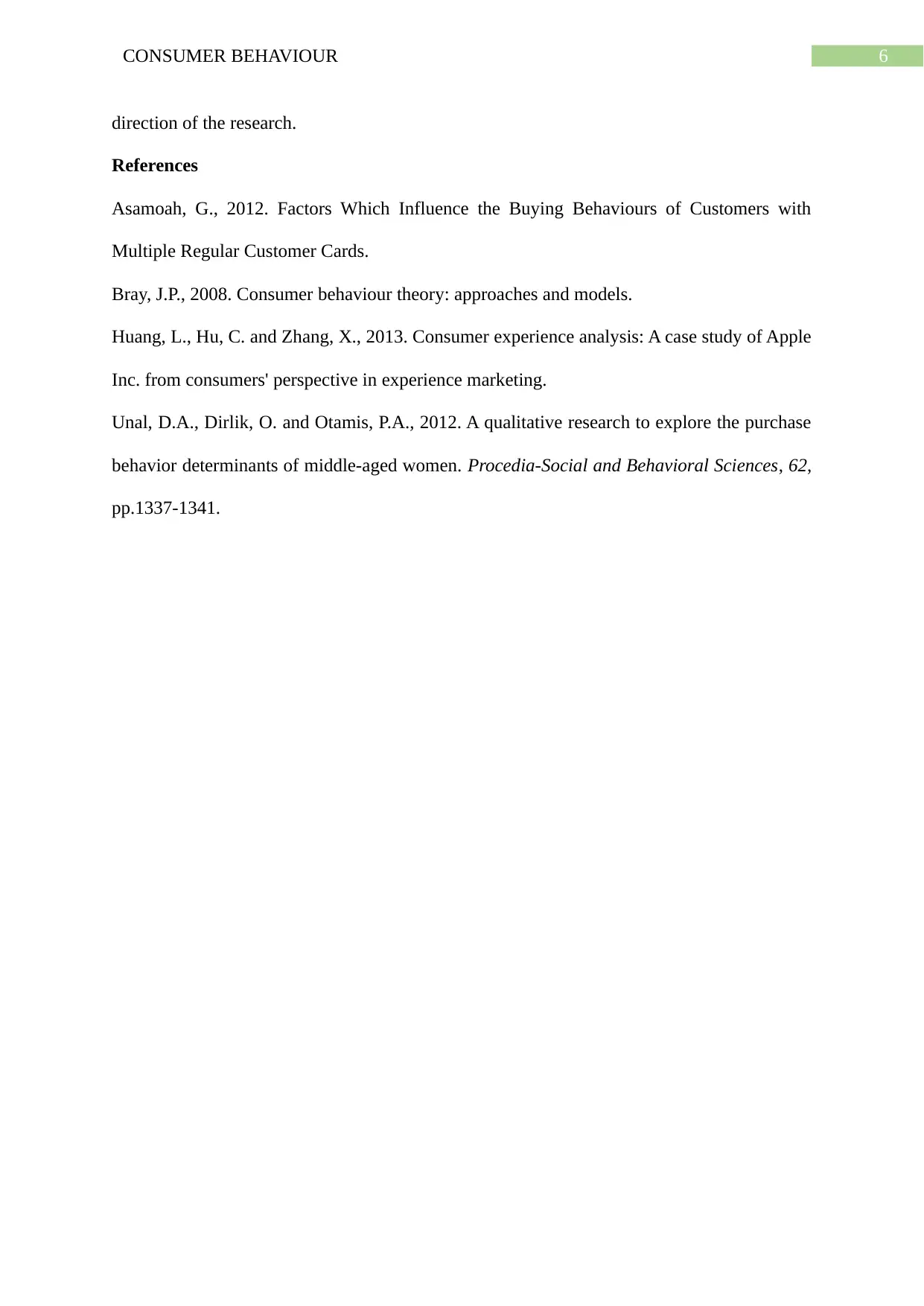
6CONSUMER BEHAVIOUR
direction of the research.
References
Asamoah, G., 2012. Factors Which Influence the Buying Behaviours of Customers with
Multiple Regular Customer Cards.
Bray, J.P., 2008. Consumer behaviour theory: approaches and models.
Huang, L., Hu, C. and Zhang, X., 2013. Consumer experience analysis: A case study of Apple
Inc. from consumers' perspective in experience marketing.
Unal, D.A., Dirlik, O. and Otamis, P.A., 2012. A qualitative research to explore the purchase
behavior determinants of middle-aged women. Procedia-Social and Behavioral Sciences, 62,
pp.1337-1341.
direction of the research.
References
Asamoah, G., 2012. Factors Which Influence the Buying Behaviours of Customers with
Multiple Regular Customer Cards.
Bray, J.P., 2008. Consumer behaviour theory: approaches and models.
Huang, L., Hu, C. and Zhang, X., 2013. Consumer experience analysis: A case study of Apple
Inc. from consumers' perspective in experience marketing.
Unal, D.A., Dirlik, O. and Otamis, P.A., 2012. A qualitative research to explore the purchase
behavior determinants of middle-aged women. Procedia-Social and Behavioral Sciences, 62,
pp.1337-1341.
1 out of 7
Related Documents
Your All-in-One AI-Powered Toolkit for Academic Success.
+13062052269
info@desklib.com
Available 24*7 on WhatsApp / Email
![[object Object]](/_next/static/media/star-bottom.7253800d.svg)
Unlock your academic potential
Copyright © 2020–2025 A2Z Services. All Rights Reserved. Developed and managed by ZUCOL.





